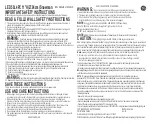
151
7.2 Conductivity
Sensor
Cleaning and Calibration
Contacting Conductivity
The frequency of cleaning for the contacting conductivity electrode varies with each installation.
The best way to determine the frequency is to compare the reading of the controller to the reading
of a calibrated hand held instrument. When the two readings differ by an amount that you deem to
be excessive (perhaps 5%), then it time to clean and recalibrate the electrode. The frequency
should be every 2-3 months or so.
To clean the contacting conductivity electrode, close the isolation valves to stop sample flow.
Open the sample valve to relieve the pressure in the manifold. Remove the nut that holds the
electrode in place. Pull the electrode straight up and out.
For loose coatings, wipe with a cloth. Avoid smearing graphite from one electrode to the other.
For removal of scale, dip in a dilute hydrochloric or gallic acid solution, and rinse.
For oils (including fingerprints!) wash with a detergent.
Reassemble all parts. Note that the conductivity electrode is keyed to only reinsert in one
orientation. Make sure that the sample valve is closed, open the isolation valves, and inspect for
leaks.
After cleaning, it is necessary to recalibrate the electrode. This is only accurate when the electrode
is installed in the piping.
High Temperature Contacting Conductivity
The frequency of cleaning for the contacting conductivity electrode varies with each installation.
The best way to determine the frequency is to compare the reading of the controller to the reading
of a calibrated hand held instrument. When the two readings differ by an amount that you deem to
be excessive (perhaps 5%), then it time to clean and recalibrate the electrode. The frequency
should be every 2-3 months or so.
To clean the high temperature contacting conductivity electrode, close the isolation valve(s) to
stop sample flow. Open the manual blowdown bypass valve to relieve the pressure in the piping.
Remove the electrode from the pipe.
For removal of scale, dip in a dilute hydrochloric or gallic acid solution, and rinse.
For oils (including fingerprints!) wash with a detergent.
Replace the electrode in the pipe. Note that the sensor should be placed with the hole facing the
direction of flow. Open the isolation valves and inspect for leaks.
After cleaning, it is necessary to recalibrate the electrode. This is only accurate when the electrode
is installed in the piping.
Electrodeless Conductivity
The frequency of cleaning for the electrodeless conductivity electrode varies with each installation.
The best way to determine the frequency is to compare the reading of the controller to the reading
of a calibrated hand held instrument. When the two readings differ by an amount that you deem to
be excessive (perhaps 5%), then it time to clean and recalibrate the electrode. The frequency
should be every 6 months or so.
To clean the electrodeless conductivity sensor, close the isolation valves to stop sample flow.
Open the sample valve to relieve the pressure in the manifold. Remove the nut that holds the
sensor in place. Pull the sensor straight up and out.
















































